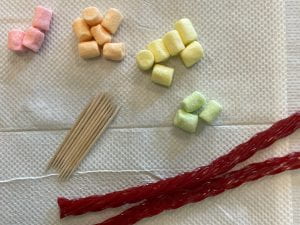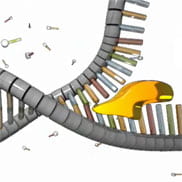For this assignment, we were asked to create a DNA model that was edible and made out of marshmallows and twizlers. I find that this assignment was fun and good to show how DNA looked and functioned, the colors were also represented in the marshmallows by using the “fruity” one. By twisting the twizlers, as will be shown in further questions, it showed how DNA looked because DNA isn’t only just a straight line, its twisted.
How does this model show:
What DNA is
DNA is an abbreviation that stands for deoxyribonucleic acid. In short, it makes life, life; it is the genetic code which is the same structure for everything, from your pet to you. This molecule has all the information needed to create a living organism. The colored marshmallows all represent something, it isn’t just all random colors that are put together on a stick in between twizlers. The pink is for cytosine, the green is for guanine and the yellow for adenine. The sides of the DNA that are being represented by the twizlers are called the backbone and the marshmallows on the toothpicks  that are stuck in between these walls are pairs of small chemicals that are called bases. The toothpicks that hold the marshmallows between the walls are the bonds between bases and the backbone. The fact that it looks like a twisted ladder is a cause of the isolation from a cell and it being stretched out (a double helix).
that are stuck in between these walls are pairs of small chemicals that are called bases. The toothpicks that hold the marshmallows between the walls are the bonds between bases and the backbone. The fact that it looks like a twisted ladder is a cause of the isolation from a cell and it being stretched out (a double helix).
What DNA does
Like mentioned in the last question about what is DNA, it is a molecule that all in all, creates life. It has the genetic code for life in short, and is very important for living things. Everything from your pet to yourself, has the same DNA structure which I find, is very cool. DNA sequences are converted into messages that can be used to create proteins which is known as genes, these can be discribed as complex molecules that do basically all of the work in our bodies but, I will learn more about that in the future I’m guessing. It is also excellent at copying itself when broken. If its broken (like I will mention in the next question), if its broken it multiplies from the broken parts. You can easily make two copies in under an hour.


How easily DNA can copy itself
DNA does a good job a replicating itself considering it takes less than an hour to do. I learnt that DNA replication can possibly occur at rates of 1,000 nucleotides/second. The original DNA strands from the double helix is the one created before the duplication; one of these strands are called the leading strand whereas the other is called the lagging strand. The leading strand is combining continuously while the other lagging strand is combined in small pieces that eventually join together to complete the new copy of the original DNA. DNA replicates fast because of the fact that multiple polymerases can  synthesize two new strands for the DNA at the same time which makes it incredibly easy for the replication process. It does this by using wounds from original DNA double helix as a template for duplication.
synthesize two new strands for the DNA at the same time which makes it incredibly easy for the replication process. It does this by using wounds from original DNA double helix as a template for duplication.
What further questions do you have after building this model?
Where to the base pairs come from when the DNA splits/ breaks apart. I am curious to know it its made up on the spot or if there’s some wort of compartment or place where the original DNA stores a new structure to start of of when it duplicated itself when broken. Is the new DNA that has been replicated better than the other or worse, is there a difference in function or is it completely the same. I wonder this because of the fact that if its building off itself, would it get weaker for example when you have to multiply the batter when your baking something, but you just add water to increase the size, it only gets bigger but the quality gets worse.
What answers can you find to your questions
The opening of the double helix, the broken bit, is the start of the duplication process, it then has a template to follow because of this broken bit; then comes the assembly of the DNA segment. During the duplication, the two strands of the double helix uncoil at a specific location which is called the origin.
Once the DNA is duplicated, I learnt that the cell actually has twice the amount of DNA that it needs. When duplicated, the two separate DNA’s are said to be, in many cases, genetically identical.
Conclusion-
I found that this lab was a great way to learn more about DNA. Before the lab, I was very confused on what DNA and molecules were; I had no clue on what a double helix was and it was confusing to convert the letters. Now I find that i am more confident in converting the letters and I know more about DNA which is a great thing to know considering I am literally made up of millions of DNA. I hope to do something like this again in the future; something fun and educational.
Sources-
One note – Mr. Robinsons notes
Class discussion- During the lab
what is DNA?
https://www.nature.com/scitable/topicpage/introduction-what-is-dna-6579978/
Replication process-
What does DNA do?



Great work posting a picture of your edible DNA with what DNA is and what DNA does. You included a complete explanation of how DNA copies itself in your own words. Good job!
Thank you very much!
You included a complete explanation of how DNA copies itself in your own words and how your model demonstrates that. Excellent work creating thoughtful questions that can be thoroughly researched. Can I use this as an example for future students?
Thank you Mr. Robinson! You can use this for an example, no problem.
Thanks for the feedback, Mr. Robinson. For sure you can use this as an example for future students!